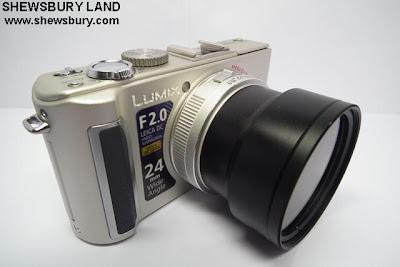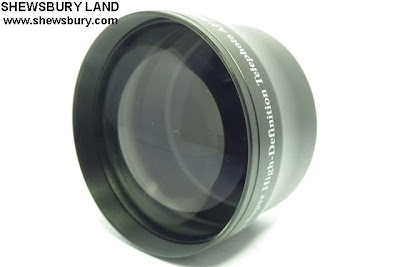Pimp My LX3 - 58mm Digital Optics 2.0x Telephoto Conversion Lens

Today I would like to introduced this 58mm Digital Optics 2.0x Telephoto Conversion Lens - basically a Telephoto Conversion Lens.
The purpose is simply to extend the optical zoom power of your existing camera lens. For example, if your camera lens have 10x optical zoom - theoretically, once you attached the telephoto conversion lens, you will get 20x optical zoom or somewhere near there.... simple as that.
But first, let's have a look at this telephoto conversion lens with the brand of "Digital Optics" - typical of those manufacturer from China who will just use simple words as their brand...







The filter thread size is 58mm which fits perfectly to my Fujifilm HS10 but the Adapter of my LX3 have filter thread size of 52mm and thus I need use the additional "Step Up Ring" from 52mm to 58mm.
This is now the step up ring adapter;


Just screw that Step Up Ring to the front of my LX3 adapter...


And after that, just attached the lens...

And this is how it looks like... a little weird though....




All right, let see some some samples;
Without the Telephoto Lens - at full zoom of 60mm for the LX3;

With 58mm Digital Optics 2.0x Telephoto Conversion Lens;

Without the Telephoto Lens - at full zoom of 60mm for the LX3;

With 58mm Digital Optics 2.0x Telephoto Conversion Lens;

Without the Telephoto Lens - at full zoom of 60mm for the LX3;

With 58mm Digital Optics 2.0x Telephoto Conversion Lens;

Probably some of you can spot the "chromatic aberration" there which is normal for cheap conversion lens like this one.
Chromatic aberration is a distortion in which there is failure of a lens to focus all colors to the same convergence point. It occurs because lenses have a different refractive index for different wavelengths of light (the dispersion of the lens). The refractive index decreases with increasing wavelength.
Chromatic aberration manifests itself as "fringes" of color along boundaries that separate dark and bright parts of the image, because each color in the optical spectrum cannot be focused at a single common point. Since the focal length f of a lens is dependent on the refractive index n, different wavelengths of light will be focused on different positions.
It can still do the job but there is some compromise that you need to accept... then again, this kind of lens is quite cheap - so pay peanuts, you get peanuts.....
People said that the telephoto conversion lens made by Olympus, namely; "Olympus TCON-17" can produced a better result with minor or minimum "chromatic aberration" but surely you have to pay for the price. If you are a serious and looking for a good long term investment, surely I would recommend the "Olympus TCON-17". I did some research on E-Bay, the prices varies - some sell within SGD 100.00 and some sell it more than SGD 100.00
In Adorama (http://www.adorama.com) the price is between USD 23.00 to USD 40.00
However, if you just want to try this for fun sake like me, then it's OK to start with those cheap brands which you can get easily from E-Bay... again, don't expect miracle, remember the keywords = pay peanuts, you get peanuts...
In addition, I would like to also share about this additional lens filters that I have.
First is the RED Color Filter... it is basically for 58mm size (Fujifilm HS10) but thanks to the "52-58mm Step Up Ring", my LX3 can use them as well....

Especially effective for increasing contrast. Ideal for dramatic cloud effects in landscapes. Can also be applied creatively in color and infrared photography. These filters are primarily designed for use with Black & White photography. However, they can be used in color photography to produce special color effects. Source : CameraFilters.com

This is the normal view....

In "Standard" color mode, if you attached the RED COLOR FILTER, it will become like this;

Now this is the "Standard B&W" view without using the RED FILTER;

And this is now in "B&W mode" and using the RED FILTER;

Next is the GREEN COLOR FILTER;

Great for correcting skin tones, bringing out facial expressions in close-ups and emphasizing the feeling of liveliness. A green filter is highly effective for indoor portraits under tungsten lighting. These filters are primarily designed for use with Black & White photography. However, they can be used in color photography to produce special color effects. Source : CameraFilters.com

I don't have any human model at this time and thus I decided to just do some simple testing on scenery shot instead;
Without the GREEN FILTER:

With the GREEN FILTER:

And lastly this NEUTRAL DENSITY FILTER;


In conditions of extreme light intensity, such as sunshine on snowy mountains or on the beach, or when using a camcorder, ND (Neutral Density) filters are recommended.
ND filters have four main uses:
1) To enable slow shutter speeds to be used, especially with fast films, to record movement in subjects such as waterfalls, clouds, cars, seas etc.
2) To decrease depth of field by allowing wider apertures to be used, which helps separate subjects from their background.
3) To decrease the effective ISO of high speed film (ie: above ISO400) and allow it to be used outdoors in bright situations.
4) To allow video cameras (which have fixed shutter speeds) to film subjects such as snow, sand or other bright scenes which would normally cause over-exposure.
Source : CameraFilters.com
And below is the sample for this NEUTRAL DENSITY FILTER;
Normal view without the filter;

And this is how it looks like when using the ND FILTER;

And that's about it for now....
end


With the Tele lens, your camera reminds me of the GM Sniper's sniper rifle scope. Big sexy optics. =D
ReplyDeletep.s. the ND filter does makes the picture more natural-like, the colours.